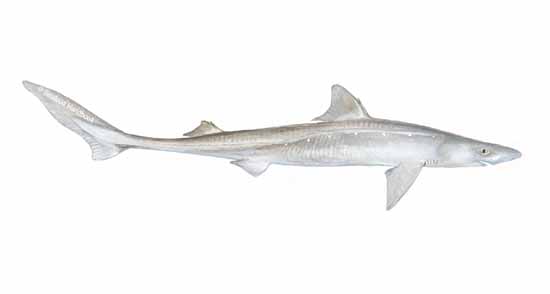Dogfish
Published on
January 23, 2014

This bone-free shark possesses many of the attributes U.S. consumers are looking for. Promoters hope to find greater acceptance for the dogfish by marketing it under a Food-and-Drug-Administration-approved alternative name: “Cape shark.” Domestically, the species is found along the Pacific Coast from the Gulf of Alaska to Point Conception, California. On the Atlantic Coast, it roams between Cape Sable, Nova Scotia, and Cape Cod. Cape shark is targeted by longliners and landed as a bycatch of gillnetters. Market size is about 3 feet, with an average weight of 7 to 10 pounds. Like all sharks, dogfish are elasmobranchs, which means they have cartilage instead of bone for a skeleton. Sharks also lack a traditional urinary tract, so they concentrate urea, a waste product, in their blood and excrete it through their skin. As soon as it’s caught, dogfish must be gutted, bled and chilled. Otherwise, the urea remains in the flesh, and an ammonia smell develops within 24 hours.
Squalus acanthius
Spiny dogfish, cape shark
Dogfish, sand shark, rock salmon (UK)
Aiguillat commun
Dornhai
Spinarolo
Aburatsunozame
Mielga
This bone-free shark possesses many of the attributes U.S. consumers are looking for. Promoters hope to find greater acceptance for the dogfish by marketing it under a Food-and-Drug-Administration-approved alternative name: “Cape shark.” Domestically, the species is found along the Pacific Coast from the Gulf of Alaska to Point Conception, California. On the Atlantic Coast, it roams between Cape Sable, Nova Scotia, and Cape Cod. Cape shark is targeted by longliners and landed as a bycatch of gillnetters. Market size is about 3 feet, with an average weight of 7 to 10 pounds. Like all sharks, dogfish are elasmobranchs, which means they have cartilage instead of bone for a skeleton. Sharks also lack a traditional urinary tract, so they concentrate urea, a waste product, in their blood and excrete it through their skin. As soon as it’s caught, dogfish must be gutted, bled and chilled. Otherwise, the urea remains in the flesh, and an ammonia smell develops within 24 hours.
Spiny dogfish meat has a sweet, mild flavor and a higher oil content than mako or other sharks. It has a flaky yet firm texture. The raw meat is white. The outer flesh can have a reddish color. If not cut away, the reddish portion turns brown when cooked. The rest of the meat cooks up white. The oil content helps keep the flesh moist.Dogfish meat should have a faintly sweet smell; although a slight metallic odor is acceptable, an ammonia taint is not.
| Calories: | 130 |
| Fat Calories: | 41 |
| Total Fat: | 4.5 g |
| Saturated Fat: | 0.9 g |
| Cholesterol: | 51 mg |
| Sodium: | 79 mg |
| Protein: | 20.9 g |
| Omega 3: | 0.9 g |
Creative cooking suggestions and preparations will increase customers’ willingness to try this versatile species. You can deep fry spiny dogfish, as the British do for fish and chips, but don’t stop there. Use cubed meat for kebabs or in stir fries. Dogfish smokes nicely because of its oily flesh. The fins can be used in shark-fin soup, and the firm meat makes an ideal chowder ingredient.
Mackerel, Other sharks
- Bake
- Boil
- Broil
- Fry
- Grill
- Pate
- Poach
- Saute
- Smoke
- Steam
Fresh: Whole, H&G, Fillets (skin-on/skinless), Steaks, Backs
Frozen: H&G, Fillets (skin-off), Steaks, Backs
Value-added: Livers, Dried fins, Tails, Smoked belly flaps
Canada, Iceland, Norway, UK, United States





